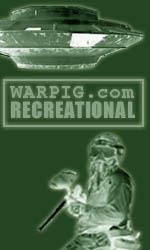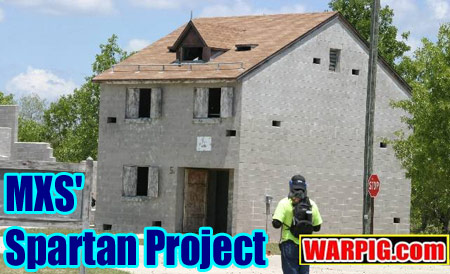  |
|
|
|
|
|
|
  |
|
|
|
|
|
|

What do you think? Add your comments in WARPIG's REC TALK Forum
|

MXS Spartan Project May 27-28, 2006 by Bill Mills - Photos by Dawn Mills For the first days of the 2006 Memorial Day weekend, the Camp Blanding MOUT site was once again opened for scenario Paintball. Camp Blanding, located near the town of Starke, Florida is owned by the state of Florida, and operated by the Florida National Guard. It is accessible to all branches of the military, state, local and federal law enforcement agencies, and even civilian groups for both training and recreation.
For event producers, Mackz Extreme Sportz, the Spartan Project marked their third scenario game to be held at Blanding. The first, in the summer of 2001, was well received, but the sudden increase in homeland security that came a few months later meant that Blanding was heavily booked by government agencies, who always get scheduling priority over civilian use. It wasn’t until the fall of 2005 that the site would see paintball gain.
Use of the specific event only paint also meant that last minute walk-on paint purchases wouldn’t work – players needed to register and reserve paint by the listed deadlines. More than 50 last minute would-be players found themselves turned away because they didn’t plan ahead. The second half of the cleanliness equation for MXS came not from the type of paint, but from cleaning it up after the game. In 2001 a team from the MXS staff took several days to clean the site with portable pressure washers. In 2005 a new plan came together. With a donation to support a local volunteer fire department, fire training became an immediate follow-up to the scenario game. In a single day, using the massive pumps and hoses of their fire truck, a team of volunteer firefighters was able to clean the site while getting valuable training time in with their equipment.
Game time started Saturday morning, an hour before noon – the Spartan Project was on. The game was themed on the universe of the HALO video game. Humans, from the UNSC Navy and Marines would face off against aliens who were part of “The Covenant.”
While the humans had a strategic eye on the MOUT site, the Covenant viewed it from a religious standpoint. Made up of various alien races all following the teachings of a central prophet, they were in search of a small glowing box, which they believed to be an oracle, critical to their faith. A new group of aliens fresh to the Covenant were eager to prove their allegiance by signing on to fight the “great demons” known as the Spartans. And so it began. The game started with an interesting twist. Instead of simply starting both teams from opposing sides of the field, leadership from both teams agreed to something different. Each team was allowed to select one building and start with twenty players in that structure, while the rest started at their respective bases. As this played out, both teams selected sites that were downfield of their opponents, meaning that the distribution started with the humans at one end, a group of Covenant, a group of humans, and then the rest of the Covenant forces. Each of the elite starters were positioned to take fire on two fronts, which led to much paint being thrown, incidents of friendly fire and fun chaos. The game commenced at 11:00 am on Saturday, and with more than 700 players the MOUT site was full of action. Bill “Duncan” Dunlap of the Florida based Duncan’s Raiders was the general commanding the Covenant forces in their blue armbands. By mid-day Duncan described the game as going well for the Covenant. “It’s been challenging,” he said. “We’ve controlled the things we’ve wanted controlled. We give them this, and keep that. They’re fighting hard.” Duncan hoped to “rule the night and mop up in the morning,” as three out of the four top teams playing for the Covenant were fully night vision equipped.
In contrast Harold “Pop” Speich from Georgia based Children of the Korn ran a different style of command for the red-banded human team. In his first time as general of an MXS scenario Pop also split his XOs and teams into three units, but he placed them based on geography, and rotated commands through the different section of the games. His goal was to make sure every player had a taste of all that Blanding had to offer – defending the base, fighting through the woods, or taking it door to door in the city. Pop’s strategy for the night was to dig in and stay alive – to hold their own and then some. Both generals commented that they enjoyed the unusual starting format. “I enjoyed the entry,” said Pop, “I thought it worked out real well, my son Jeremy suggested it.” The game was also graced with four paintball tanks. A four wheeled tank with full crew is uncommon at many scenarios, but was the most “usual” of the paintball tanks at Blanding. Another fully crewed tank was built on the chassis of a three wheeled electric vehicle rolled and patrolled silently, letting out hailstorms of paint where needed. Size and numbers of wheels got smaller from there. A Segway XT cross terrain two-wheeled transport was equipped with a PVC and net framework. Because the General Rules of Scenario play use a Nerf projectile from a LAW launcher to take out a tank, rather than paintballs, the bounce-factor of a fully netted tank is no longer a design factor as it used to be. The result was an unusually tall, and surprisingly agile tank moving quickly throughout the city. Even though paintballs don’t take it out of the game, many players found it a fun target, with deluges of paintballs distracting its single person crew from its goal. The third tank at the game had no crew at all. It was a compact remotely controlled combat platform, looking not too unlike Foster-Miller’s SWORDS robot. The bot’s compact wheeled platform sported a remotely fired Tippmann up top, and its compact size made it a difficult target for LAWs rounds. The game continued on up to the 5:00 pm dinner break. Having voted to skip a possible 2:00 pm hydration break, the players had to make sure they kept loading up on water between reinsertions. With white concrete road surfaces much of the site had the effect of a reflector oven, hitting players with sunlight from both above and below. Night play began at 8:00 pm and ran through 2:00 am. The remainder of the game was played from eight to noon on Sunday morning. When all was said and done, the Covenant came out victorious. Of the two biggest missions at the end of the game, the Covenant failed to find and transport the oracle to the top of the tallest building for transport. Although the human forces did get the nuclear device they needed from the top of the building down into the city, they hadn’t amassed as many points from running missions as the Covenant. With a final score of 542 to 418, the Covenant was victorious. Storm Troopers of Death were named Most Valuable Team for the Covenant team, while Adrenaline Rush took the same honors for the humans. Billy Smith of Low Country paintball was cited as the Covenant’s Most Valuable Player, while it was Ashley, the Human’s radio operative who was named their MVP. Site cleanup after the game proceeded even faster than it had at previous Blanding games, and MXS credited much of that to players staying on top of policing their own garbage and keeping the staging area orderly. They thanked Colonel Nelson and Major Couley of the Florida Army National Guard for making the game possible, as well as Sergeant First Class Hall for support provided during the game. From Starke, FL, the next stop in MXS’s traveling scenario series would be “The Conch Republic” game at Old River Paintball in Ocklawaha, Florida on the weekend of June 24th. The light hearted game will be based on so-called actual events in the 1982 Key West protest to US border patrol searches of boats, in which stale loaves of Cuban bread became missiles in a short lived revolt and secession from the Union.
|
| Copyright © 1992-2019
Corinthian Media Services. WARPIG's webmasters can be reached through our feedback form. All articles and images are copyrighted and may not be redistributed without the written permission of their original creators and Corinthian Media Services. The WARPIG paintball page is a collection of information and pointers to sources from around the internet and other locations. As such, Corinthian Media Services makes no claims to the trustworthiness or reliability of said information. The information contained in, and referenced by WARPIG, should not be used as a substitute for safety information from trained professionals in the paintball industry. |